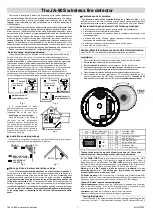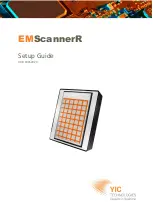
PAGE 21 OF 80
NIGHT SCAN CHIEF
OPERATING INSTRUCTIONS
TP-4602001-T
DECEMBER 2020
5 Installation
This section describes the physical and electrical installation of the Night Scan Chief and pro
-
vides the general procedures that must be followed to ensure a successful installation. Be sure to
read and understand the entire installation procedure and the Safety Summary Section 1 before
beginning installation.
5.1 Mounting Location Requirements
The following factors must be included when selecting an appropriate mounting location.
1. Your system is designed to withstand adverse weather conditions, however it cannot be sub
-
merged in water. If the system is mounted in a well, provide adequate drainage. A minimum
of four 1 inch (25mm) diameter drain holes (one per corner) are recommended.
2. Ensure that the mast base and saddle are on a flat surface and in the same plane. The
Stowed Limit Switch is set at the factory based on a level surface. If the system is not level,
these switches may need adjusted as described in Section 7.5.3.
3. The mounting location needs to have access holes to install the necessary wiring through the
access holes in the bottom of the mast base (see Figure 3-3 for location of holes).
4. The installed elevation of the bottom of the mast base shall be at least 2.7 meters (8.8 feet)
above ground level to prevent reach of upper extremities during operation. Alternatively,
lower elevations are permitted if the mast is properly guarded by the installer or offset
towards the middle of the roof with reach limited by vehicle structure to prevent contact with
the mast during operation.
5. The mounting surface needs to be strong enough to support the mast loading under all oper
-
ating conditions. The following are static weights for the Night Scan Chief with various lights:
• 100 lb (45 kg) for DC and 1,800 watt AC lights
• 110 lb (50 kg) for 3,000 watt AC lights
• 120 lb (54 kg) for 5,400 watt AC lights
• 130 lb (59 kg) for 6,000 watt AC lights
6. It is important that both the base and the saddle be securely mounted to a sturdy roof or plat
-
form which will not overturn during operational loading of the mast. The surface must be rein
-
forced to withstand the load at the different points on the mast that can be expected during
operation as shown in Figure 5-1. These are maximum load estimates placed downward and
sometimes upward on the vehicle top by the mast.
Summary of Contents for Night Scan Chief 1.0
Page 2: ......
Page 6: ...PAGE 4 OF 80 NIGHT SCAN CHIEF OPERATING INSTRUCTIONS TP 4602001 T DECEMBER 2020 ...
Page 22: ...PAGE 20 OF 80 NIGHT SCAN CHIEF OPERATING INSTRUCTIONS TP 4602001 T DECEMBER 2020 ...
Page 55: ...PAGE 53 OF 80 NIGHT SCAN CHIEF OPERATING INSTRUCTIONS TP 4602001 T DECEMBER 2020 ...
Page 56: ...PAGE 54 OF 80 NIGHT SCAN CHIEF OPERATING INSTRUCTIONS TP 4602001 T DECEMBER 2020 ...
Page 57: ...PAGE 55 OF 80 NIGHT SCAN CHIEF OPERATING INSTRUCTIONS TP 4602001 T DECEMBER 2020 ...
Page 58: ...PAGE 56 OF 80 NIGHT SCAN CHIEF OPERATING INSTRUCTIONS TP 4602001 T DECEMBER 2020 ...
Page 59: ...PAGE 57 OF 80 NIGHT SCAN CHIEF OPERATING INSTRUCTIONS TP 4602001 T DECEMBER 2020 ...
Page 60: ...PAGE 58 OF 80 NIGHT SCAN CHIEF OPERATING INSTRUCTIONS TP 4602001 T DECEMBER 2020 ...
Page 62: ...PAGE 60 OF 80 NIGHT SCAN CHIEF OPERATING INSTRUCTIONS TP 4602001 T DECEMBER 2020 ...
Page 63: ...PAGE 61 OF 80 NIGHT SCAN CHIEF OPERATING INSTRUCTIONS TP 4602001 T DECEMBER 2020 ...
Page 64: ...PAGE 62 OF 80 NIGHT SCAN CHIEF OPERATING INSTRUCTIONS TP 4602001 T DECEMBER 2020 ...
Page 76: ...PAGE 74 OF 80 NIGHT SCAN CHIEF OPERATING INSTRUCTIONS TP 4602001 T DECEMBER 2020 ...
Page 81: ...PAGE 79 OF 80 NIGHT SCAN CHIEF OPERATING INSTRUCTIONS TP 4602001 T DECEMBER 2020 ...
Page 82: ...PAGE 80 OF 80 NIGHT SCAN CHIEF OPERATING INSTRUCTIONS TP 4602001 T DECEMBER 2020 ...
















































